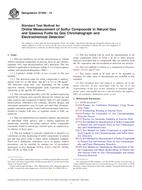Potřebujeme váš souhlas k využití jednotlivých dat, aby se vám mimo jiné mohly ukazovat informace týkající se vašich zájmů. Souhlas udělíte kliknutím na tlačítko „OK“.
ASTM D7756-13
Standard Test Method for Residues in Liquefied Petroleum (LP) Gases by Gas Chromatography with Liquid, On-Column Injection
Automaticky přeložený název:
Standardní zkušební metoda pro rezidua v zkapalněný ropný (LP) plynů pomocí plynové chromatografie s tekutinou, do kolony injekce
NORMA vydána dne 15.6.2013
Informace o normě:
Označení normy: ASTM D7756-13
Poznámka: NEPLATNÁ
Datum vydání normy: 15.6.2013
Kód zboží: NS-39072
Počet stran: 13
Přibližná hmotnost: 39 g (0.09 liber)
Země: Americká technická norma
Kategorie: Technické normy ASTM
Kategorie - podobné normy:
Anotace textu normy ASTM D7756-13 :
Keywords:
contaminants, gas chromatography, liquefied petroleum gases, LPG, mineral oil, oily residue, residue, ICS Number Code 75.160.30 (Gaseous fuels)
Doplňující informace
| Significance and Use | ||||||||||||||||||||||||
|
5.1 Control over the residue content as specified in Specification D1835 is of considerable importance in end-use applications of LPG. Oily residue in LPG is contamination which can occur during production, transportation, or storage. 5.2 This test method is quicker and much more sensitive than manual methods, such as Test Method D2158, which is based on evaporation of large sample volumes followed by visual or gravimetric estimation of residue content. 5.3 This test method provides enhanced sensitivity in measurements of heavier (oily) residues, with a quantification limit of 10 mg/kg total residue. 5.4 This test method gives both quantitative results and information about contaminant composition such as boiling point range and fingerprint, which can be very useful in tracing the source of a particular contaminant. |
||||||||||||||||||||||||
| 1. Scope | ||||||||||||||||||||||||
|
1.1 This test method covers the determination, by gas chromatography, of soluble hydrocarbon materials, sometimes called “oily residue,” which can be present in Liquefied Petroleum (LP) Gases and which are substantially less volatile than the LPG product. 1.2 This test method quantifies, in the range of 10 to 600 mg/kg (ppm mass), the residue with a boiling point between 174°C and 522°C (C10 to C40) in LPG. Higher boiling materials, or materials that adhere permanently to the chromatographic column, will not be detected. 1.3 Appendix X3 and Appendix X4 describe additional applications which could be performed based on the hardware and procedures described in this test method. Appendix X3 describes a test procedure for expanding the analysis range to benzene, and Appendix X4 describes a test procedure for the analysis of diisopropanolamine in LPG. 1.4 Units—The values stated in SI units are to be regarded as standard. The values given in parentheses are for information only. 1.5 This standard does not purport to address all of the safety concerns, if any, associated with its use. It is the responsibility of the user of this standard to establish appropriate safety and health practices and determine the applicability of regulatory limitations prior to use. |
||||||||||||||||||||||||
| 2. Referenced Documents | ||||||||||||||||||||||||
|
Podobné normy:
Historická
15.4.2009
Historická
1.6.2009
Historická
1.6.2014
Historická
1.10.2013
Historická
1.11.2012
Historická
1.6.2014
Odebírejte informace o nově vydaných normách ZDARMA:
Chcete pravidelně odebírat informace o nově vycházejících normách z celého světa a to zcela zdarma?
Přihlašte se k odběru. Vše je velice jednoduché a absolutně ZDARMA.
Na výběr máte vydavatele z celého světa.



 ASTM D6897-09
ASTM D6897-09 ASTM D6968-03(2009)..
ASTM D6968-03(2009).. ASTM D7493-14
ASTM D7493-14 ASTM D7607/D7607M-11..
ASTM D7607/D7607M-11.. ASTM D7828-12
ASTM D7828-12 ASTM D7833-14
ASTM D7833-14
 Cookies
Cookies
